

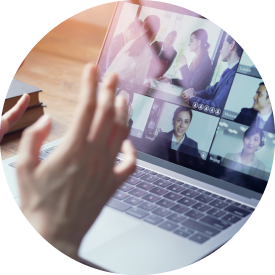

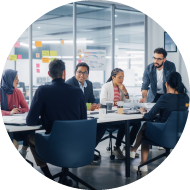

Creating a More Comfortable,
Employee-Friendly
Working Environment
to Increase Job Satisfaction
Organization Development Section,
Human Resources Planning Department,
Human Resources Development Division,
Corporate General Affairs Human Resources Group

Strengthening employee
relationships now and post
COVID-19


―Tell us a little about your current work.
The Human Resources Planning Department is in charge of developing Kyocera’s personnel system as a whole, including working practices and rules and designing measures to increase employee motivation. I am assigned to the Organization Development Section. We focus on creating a working environment that increases work satisfaction and organizing programs to develop Kyocera’s human resources. For a while after joining the company, I was involved in the operation of a wide range of consultation and mentor systems1 to help employees better enjoy their work and increase employee retention. I am now engaged in the preliminary survey for the introduction of a system that will allow employees to give feedback to their supervisors.2
Note 1: The mentor system assigns experienced employees who are close in age to newly hired employees as mentors
with whom they can consult.
Note 2: An evaluation system that provides employees in supervisory positions opportunities to see themselves
objectively and facilitates improvement through feedback from subordinates on their interpersonal communication
and behavior.
While I’m working on planning and operating programs central to the company’s HR, I am still just learning about Kyocera. Due to the COVID-19 pandemic, most of my new employee training was online, and on-site practical training at plants was postponed. Even now, we cannot visit Kyocera facilities to observe the on-site conditions where our HR programs are applied. Therefore, we listen to employees when they visit HQ and have online training for junior employees. Because of this, I try to make the most of any opportunity to learn about on-site conditions.
―On which sustainable development activities are the HR Planning Department working?
Among the sustainable development goals set out by the UN, Kyocera’s HR Planning Department is working on creating “Decent Work and Economic Growth.” In order for companies to grow, it is essential to create an environment in which employees gain work satisfaction and personal development. Conventionally, Kyocera has strived to deepen the bonds among employees not only through work but also through various outside work events. This helped us successfully build the trusting relationships which form the foundation of Kyocera today. However, with the increase of remote work due to the pandemic, it is difficult to have face-to-face communication. As a result, the HR development team needs to seek new ways to facilitate employee interaction and communication .
To help eliminate such barriers to communication, we organized an online event in autumn 2021 for employees at our global headquarters, where we facilitated group discussions after presentations by instructors through cross-organizational teams. After the event, we received many positive comments from participants who enjoyed the opportunity to hear different viewpoints from other employees. Through this, I realized how much individual employees want to build horizontal relationships, and I strongly feel that our mission is to develop post-COVID ways for interaction and communication, including proactively creating such opportunities.
―Are you conscious of sustainable development goals at work or during your daily life?
I want the world to be free of gender discrimination. When studying Danish as a university student, I learned that Northern Europe has less of a gender gap than Japan. According to the Global Gender Gap Index3 2021 published by the World Economic Forum (WEF), the five top countries for gender equality are in Northern Europe, while Japan is the 120th. It is unfortunate that Japan lags so far behind the global trend; however, we can improve the situation through specific measures and other environmental factors. I really hope that Japan will be much better in the near future.
Note 3: The Global Gender Gap Index shows disparities between male and female conditions in 156 countries and reported by the WEF since 2006.
Kyocera has a child-care leave system, but those taking leave are mainly female employees. To increase the number of male employees taking advantage of child-care leave, it is necessary to build awareness among employees throughout the company, not just those who have young children at home. I want to learn about different employees’ needs to create an environment where everyone can adjust their work to match changes in their lifestyles, changes such as having children.

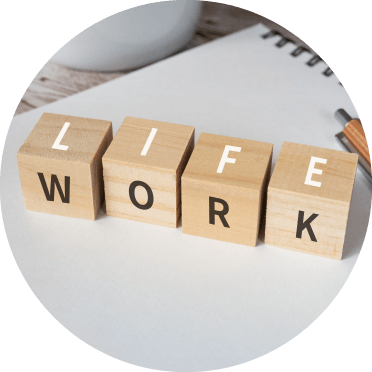

Employee-oriented management
philosophy that creates economic
growth and employee
satisfaction
―To which sustainable development activities do millennials or Generation Z expect companies to contribute?
Most sustainability development targets are in some way connected to our daily lives so we are very attuned to them. For Gen Z in particular, these are directly related to our future, so we have significant interest, I think.
Job satisfaction is also an important issue for potential employees when they are students. Because many people work part-time jobs through school, they’ve had the opportunity to think about what work means to them. Companies need to show how they can help improve employees’ lives and create an environment for employee growth. I also think it is important for companies to view things from the same perspective as our generation and fully utilize social media and other tools which appeal to our values and ways of thinking.
―What did you focus on when choosing a company?
I wanted to know how employees at the company thought about and approached their work. Some companies do not give any chances to interact with employees other than HR during the application process. Kyocera, on the other hand, was proactive about providing opportunities to meet current company employees. I got a strong impression that everyone sincerely enjoyed working here, which made me want to join the team. Because I was able to do meet current employees before joining Kyocera, I’ve never felt a gap between my expectations before being hired and my experience after starting work. I am also doing work that I enjoy, which makes my day-to-day work truly satisfying.
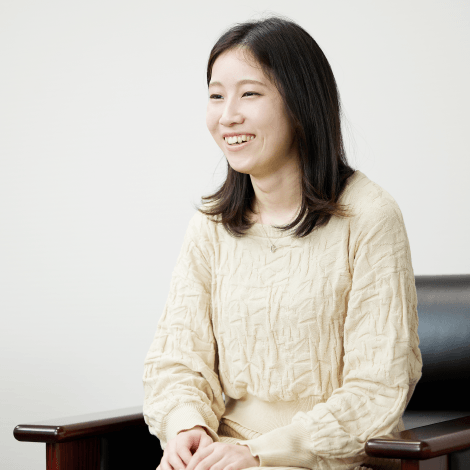
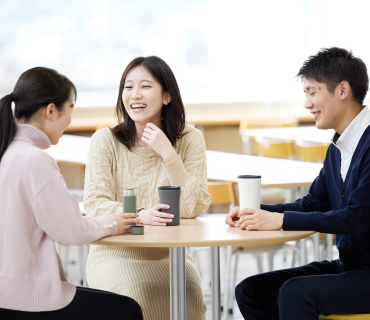
―What are Kyocera’s strengths in its approach to sustainable development goals?
Kyocera’s management rationale begins with the phrase, “To provide opportunities for the material and intellectual growth of all our employees.” About 60 years ago, during Japan’s period of high economic growth, Kyocera’s founder, Kazuo Inamori, prioritized people in his management philosophy. This was, I believe, because he wanted to create an exceptional company where all employees could believe in each other and truly be happy to work. With such a management philosophy that places importance on the bonds between humans, Kyocera has continued to seek employee satisfaction hand-in-hand with business growth.
In contemporary society, people’s values are diversifying. The era when people will work simply as long as they get paid is over. Instead, companies must focus on ways to make employees proud of their work. When employees on the manufacturing floor can take pride in how the products they make are used throughout society, and when those in support departments are proud of their role in the company, I strongly believe all that energy will create a virtuous cycle that will drive Kyocera’s growth.
―What are your goals for contributing to sustainable development goals
My current goal is to design work environment programs that support each employee’s work satisfaction. In order to do so, I need to learn more about Kyocera’s operating sites and factories. I am worried about not having a broad enough perspective and making unrealistic proposals if I only work at HQ. I have opportunities to talk with on-site managers to provide feedback after evaluations by subordinates; however, I am afraid that my suggestions may be inappropriate due to a lack of knowledge or experience regarding on-site operations.
I think it is important to keep visiting Kyocera’s various work sites, listen to employees, and identify diverse needs to gather the knowledge and experience required to develop more effective approaches.
Kyocera's initiatives for the future
Human Resource Development
Kyocera Group regards human resources as the company’s most important asset and engages in activities to support personal development and increase job satisfaction in the workplace. As personal development can be achieved to a great extent through work, Kyocera strives to create a workplace that enables each employee to work cheerfully and energetically to draw out each employees’ natural talents to the maximum possible extent. Kyocera provides comprehensive support for employee growth and development using the following systems:
1. Support for the development of junior employees and career development
- Training manager system, mentor system
- Career development support (annual training and interview system)
- Step-up system
2. Challenge System
3. Internal placement application system
4. Human resource education
5. Management education
6. Technical training
7. Global education
8. Training to support diverse career experiences (e.g. secondments to venture companies)
9. Kyocera Philosophy Education





